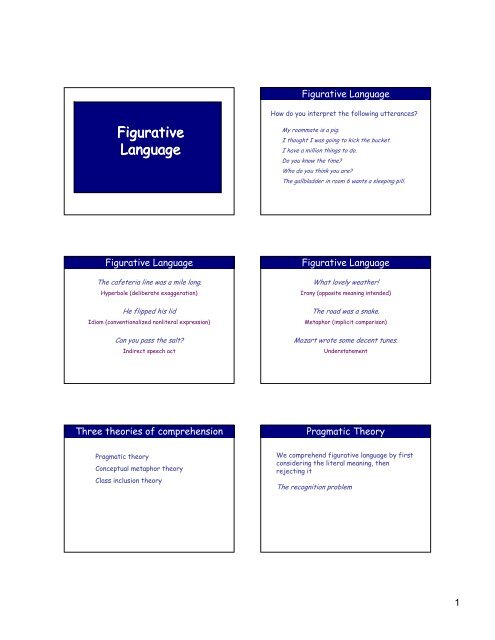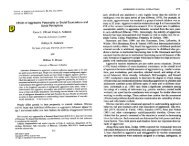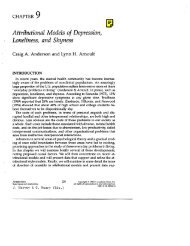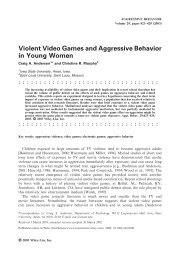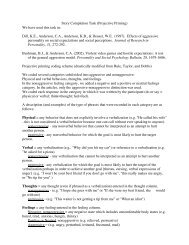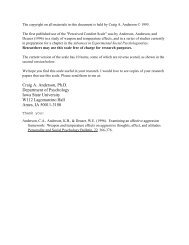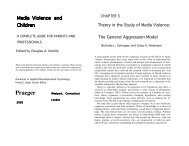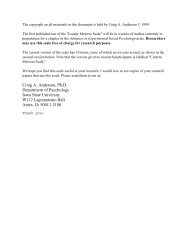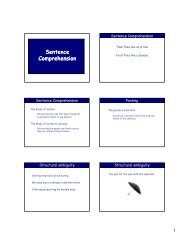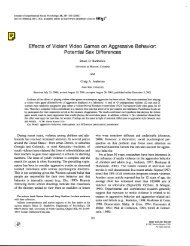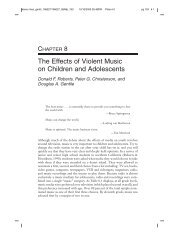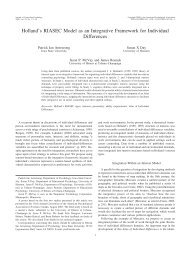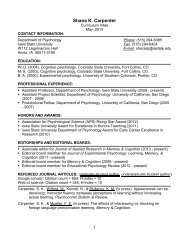Figurative Language
Figurative Language
Figurative Language
Create successful ePaper yourself
Turn your PDF publications into a flip-book with our unique Google optimized e-Paper software.
<strong>Figurative</strong> <strong>Language</strong><br />
<strong>Figurative</strong><br />
<strong>Language</strong><br />
How do you interpret the following utterances?<br />
My roommate is a pig.<br />
I thought I was going to kick the bucket.<br />
I have a million things to do.<br />
Do you know the time?<br />
Who do you think you are?<br />
The gallbladder in room 6 wants a sleeping pill.<br />
<strong>Figurative</strong> <strong>Language</strong><br />
The cafeteria line was a mile long.<br />
Hyperbole (deliberate exaggeration)<br />
He flipped his lid<br />
Idiom (conventionalized nonliteral expression)<br />
Can you pass the salt?<br />
Indirect speech act<br />
<strong>Figurative</strong> <strong>Language</strong><br />
What lovely weather!<br />
Irony (opposite meaning intended)<br />
The road was a snake.<br />
Metaphor (implicit comparison)<br />
Mozart wrote some decent tunes.<br />
Understatement<br />
Three theories of comprehension<br />
Pragmatic Theory<br />
Pragmatic theory<br />
Conceptual metaphor theory<br />
Class inclusion theory<br />
We comprehend figurative language by first<br />
considering the literal meaning, then<br />
rejecting it<br />
The recognition problem<br />
1
The recognition problem<br />
One possibility – Is the literal<br />
interpretation true or false?<br />
Deb’s a real tiger<br />
?<br />
The recognition problem<br />
BUT… many literally true expressions are<br />
assigned a non-literal meaning<br />
John is a real Marine<br />
My wife is an animal<br />
The recognition problem<br />
Reject the literal meaning based on<br />
pragmatics? (Grice, 1989)<br />
Pragmatics = the social rules underlying<br />
language use<br />
Can you get me a beer?<br />
Rules of Conversation<br />
Grice’s Cooperative Principle:<br />
What we say in conversation should further<br />
the purposes of the conversation<br />
Kim: How are you today?<br />
Sandy: Oh, Harrisburg is the capital of<br />
Pennsylvania.<br />
Kim: Really? I though the weather would be<br />
warmer.<br />
Sandy: Well, in my opinion, the soup could<br />
use a little more salt.<br />
Felicitous or infelicitous?<br />
What do you do for a living?<br />
I’m a psychology professor at Iowa State<br />
What do you do for a living?<br />
#I have a job<br />
What do you do for a living?<br />
#My favorite color is purple, too!<br />
Grice’s Maxims<br />
Rules of Conversation<br />
The Maxims of Quality:<br />
Do not say what you believe to be false.<br />
Do not say that for which you lack adequate evidence.<br />
The venom of the purple-toothed spider isn’t<br />
strong enough to kill people.<br />
2
Grice’s Maxims<br />
Rules of Conversation<br />
The Maxim of Relevance<br />
Be relevant.<br />
Kim: How are you today?<br />
Sandy: Oh, Harrisburg is the capital of<br />
Pennsylvania.<br />
Alana: Is Jamie dating anyone these days?<br />
Sam: Well, she goes to Cleveland every weekend.<br />
Rules of Conversation<br />
Grice’s Maxims<br />
The Maxims of Quantity<br />
Make your contribution as informative as required.<br />
Do not make your contribution more informative<br />
than is required.<br />
Kim: Where did you grow up?<br />
Sandy: On the corner of Main Street and Minor Road.<br />
In Dubuque.<br />
In Dubuque, Iowa.<br />
In Iowa.<br />
In the Midwest.<br />
In the United States.<br />
Grice’s Maxims<br />
Rules of Conversation<br />
The Maxims of Manner<br />
Avoid obscurity of expression (avoid jargon and<br />
needless complexity).<br />
Avoid ambiguity.<br />
Be brief.<br />
Be orderly.<br />
What do you do for a living?<br />
#What I do is that I’m a professor and the subject<br />
matter that I teach is psychology.<br />
Grice’s Maxims<br />
Rules of Conversation<br />
The Maxims of Manner<br />
Avoid obscurity of expression (avoid jargon and<br />
needless complexity).<br />
Avoid ambiguity.<br />
Be brief.<br />
Be orderly.<br />
#My mother didn’t really want my room to be painted purple. I<br />
was worried that I wouldn’t get good grades at the new school.<br />
When I was a child, m favorite color was purple. I worked very<br />
hard in all of my classes to get good grades. My mother told me<br />
that if I got good grades, I could paint my room.<br />
Flouting the maxims<br />
Flouting the maxims<br />
How many times have you…<br />
…told a lie?<br />
… changed the subject?<br />
… given too much information?<br />
… said something confusing?<br />
Good morning!<br />
I wonder<br />
what he<br />
meant by<br />
that?<br />
3
Flouting the maxims<br />
Dear Colleague:<br />
I am very pleased to be able to recommend Irving<br />
Smith to you. Mr. Smith is a model student. He<br />
dresses well and is extremely punctual. I have<br />
known Mr. Smith for three years now, and in every<br />
way I have found him to be most cooperative. His<br />
wife is charming.<br />
Sincerely,<br />
John Jones<br />
Professor<br />
Pragmatic Theory<br />
Can you get me a beer?<br />
Pragmatic Theory<br />
Pragmatic Theory<br />
We comprehend figurative language by first<br />
considering the literal meaning, then<br />
rejecting it (based on Gricean maxims)<br />
Searle (1975) outlines several stages…<br />
Searle’s stages<br />
Stage 1: Extract literal meaning<br />
Stage 2: Listener decides whether literal<br />
meaning is what was intended<br />
Stage 3: Compute an alternative meaning<br />
Pragmatic Theory<br />
Comprehending Metaphors<br />
Prediction: Literal meaning should be easier<br />
or faster to comprehend than figurative<br />
meaning<br />
“a child is a snowflake”<br />
topic<br />
vehicle<br />
ground = implied similarity between topic and vehicle<br />
4
Connine and Blasko (1993)<br />
“Indecision is a whirlpool”<br />
Participants listened to novel metaphors<br />
“Indecision is a whirlpool”<br />
followed by visually presented words<br />
WATER<br />
“Indecision is a whirlpool”<br />
Connine and Blasko (1993)<br />
CONFUSION<br />
water<br />
confusion<br />
equally fast<br />
Ortony, Schallert, Reynolds, & Antos (1978)<br />
Overall, evidence from early studies was<br />
mixed<br />
Ortony et al. suggested that the Pragmatic<br />
account is too limited<br />
Maybe context serves as a conceptual<br />
framework?<br />
Ortony, Schallert, Reynolds, & Antos (1978)<br />
Exp 1<br />
Predictions:<br />
1. With insufficient context, metaphors<br />
should take longer to process than<br />
targets requiring a literal interpretation<br />
2. With sufficient context, metaphors<br />
should not take longer to process<br />
5
Materials<br />
“Vignettes” consisting of antecedent context and<br />
sentence-length target<br />
Literal inducing context:<br />
Approaching the enemy infantry, the men were<br />
worried about touching off landmines. They were<br />
very anxious that their presence would be<br />
detected prematurely. These fears were<br />
compounded by the knowledge that they might be<br />
isolated from their reinforcements. The outlook<br />
was grim.<br />
Target:<br />
Regardless of the danger, the troops marched on.<br />
Materials<br />
“Vignettes” consisting of antecedent context and<br />
sentence-length target<br />
Metaphorical inducing context:<br />
The children continued to annoy their babysitter.<br />
She told the little boys she would not tolerate any<br />
more bad behavior. Climbing all over the furniture<br />
was not allowed. She threatened to spank them if<br />
they continued to stomp, run and scream around<br />
the room. The children knew that her spankings<br />
hurt.<br />
Target:<br />
Regardless of the danger, the troops marched on.<br />
Short context condition<br />
Materials<br />
Approaching the enemy infantry, regardless of<br />
the danger, the troops marched on.<br />
The children continued to annoy their babysitter.<br />
Regardless of the danger, the troops marched on.<br />
Procedure<br />
•Press space bar<br />
•Read and understand context<br />
•Press space bar<br />
•Read and understand target reading time<br />
•Press space bar<br />
•Complete posttest (write brief summaries of<br />
how each target was interpreted)<br />
Results<br />
Conclusion<br />
Reading<br />
Time<br />
(ms)<br />
4500<br />
4000<br />
3500<br />
3000<br />
2500<br />
sig<br />
Literals<br />
Metaphors<br />
We don’t always need to interpret an<br />
utterance literally before constructing a<br />
non-literal interpretation<br />
Refutes the stage model<br />
2000<br />
n.s.<br />
1500<br />
Short<br />
Context length<br />
Long<br />
6
Experiment 2<br />
Claim: In some cases, non-literal uses of<br />
language might be processed faster than<br />
literal uses<br />
For example, if context sets up the<br />
expectation that something is irritating,<br />
it might predict the expression a pain in<br />
the ____<br />
Materials (Exp 2)<br />
Three versions of context<br />
Idiom:<br />
Dean spoiled the surprise that Joan had been<br />
planning for their mother’s birthday party. When<br />
he realized what he’d done, he apologized for<br />
having…<br />
let the cat out of the bag<br />
Materials (Exp 2)<br />
Literal:<br />
Walking back from the store, Anne found a<br />
kitten which she put in with her groceries. She<br />
got home and her puppy went wild when she…<br />
Control:<br />
let the cat out of the bag<br />
Dean spoiled the surprise that Joan had been<br />
planning for their mother’s birthday party. When<br />
he realized what he’d done, he apologized for<br />
having…<br />
Results (Exp 2)<br />
Reading time<br />
Idiom Control Literal<br />
1472 1487 1682<br />
revealed the secret<br />
Glucksberg, Glidea, & Bookin (1982)<br />
Stroop interference<br />
Claim: People cannot ignore metaphors<br />
Task: Verification<br />
Interference effect as in the Stroop task<br />
You will see some words. Name the color<br />
of the ink each word is printed in.<br />
7
Glucksberg, Glidea, & Bookin (1982)<br />
Task: Verification<br />
Statements that are literally false but<br />
metaphorically true<br />
Glucksberg, Glidea, & Bookin (1982)<br />
A. True high-typical sentences<br />
Some birds are robins<br />
B. True low-typical sentences<br />
Some birds are penguins<br />
C. Standard False sentences<br />
Some birds are apples<br />
D. Metaphors<br />
Some jobs are jails Some flutes are birds<br />
E. Scrambled metaphors<br />
Some jobs are birds Some flutes are jails<br />
Glucksberg, Glidea, & Bookin (1982)<br />
A. True high-typical sentences<br />
Some birds are robins<br />
B. True low-typical sentences<br />
Some birds are penguins<br />
Manipulation check: Mean RT for high-typical True<br />
sentences was faster than that for low-typical True<br />
sentences<br />
Glucksberg, Glidea, & Bookin (1982)<br />
If participants ignore the nonliteral meanings of<br />
the metaphors:<br />
False response RTs to metaphors = False response<br />
RTs to scrambled metaphors<br />
BUT, if participants automatically register any<br />
nonliteral meanings that are available:<br />
False response RTs to metaphors > False response<br />
RTs to scrambled metaphors<br />
Mean<br />
True<br />
Some fish are trout 1114<br />
Some birds are eagles<br />
False<br />
Some fish are eagles 1185<br />
Some birds are trout<br />
Gildea & Glucksberg (1983)<br />
Question: Do figurative primes facilitate<br />
metaphor comprehension more than literal<br />
primes?<br />
Scrambled metaphors<br />
Some jobs are snakes 1162<br />
Some roads are jails<br />
Metaphors<br />
Some jobs are jails 1239<br />
Some roads are snakes<br />
8
Materials<br />
Materials<br />
“Poor” metaphor targets chosen from<br />
previous studies<br />
Smiles are razors<br />
<strong>Figurative</strong> priming sentence<br />
Some remarks are cutting<br />
Literal priming sentence<br />
Some tools are cutting<br />
Sentence Type<br />
Filler sentences<br />
Standard true<br />
Standard false<br />
Primes/target metaphors<br />
Scrambled metaphors<br />
Examples<br />
Some birds are eagles<br />
All trout are fish<br />
Some birds are trout<br />
All eagles are fish<br />
Some foods are unhealthy/<br />
All criminals are germs<br />
Some songs are soothing/<br />
All hands are medicine<br />
All criminals are medicine/<br />
All hands are germs<br />
Procedure<br />
Results<br />
*<br />
[press start key]<br />
1500<br />
sig.<br />
Metaphor<br />
Scrambled<br />
Some winters are sharp<br />
true<br />
false<br />
RT<br />
(ms)<br />
1400<br />
n.s.<br />
sig.<br />
1300<br />
All icicles are knives<br />
true<br />
false<br />
1200<br />
Unprimed <strong>Figurative</strong> prime Literal prime<br />
CONTEXTUAL CONDITION<br />
Conclusion<br />
Conceptual Metaphor Theory<br />
Both literal and figurative priming<br />
facilitate metaphor comprehension<br />
Metaphors are instantiations of<br />
underlying conceptual metaphors<br />
Contradicts predictions of Pragmatic<br />
Theory<br />
LOVE IS A JOURNEY<br />
TIME IS MONEY<br />
ARGUMENT IS WAR<br />
9
Conceptual Metaphor Theory<br />
When we encounter a verbal metaphor<br />
it automatically activates the<br />
corresponding conceptual metaphor<br />
Nayak & Gibbs (1990)<br />
American English has many idioms with<br />
similar figurative meanings<br />
Nayak & Gibbs (1990)<br />
Conceptual Metaphor Theory<br />
American English has many idioms with<br />
similar figurative meanings<br />
Blow your stack<br />
Lose your cool<br />
Flip your lid<br />
Hit the roof<br />
Get hot under the collar<br />
Paraphrase each of the following metaphors:<br />
Our love is a bumpy roller-coaster ride.<br />
Our love is a voyage to the bottom of the<br />
sea.<br />
Our love is a dusty road traveled.<br />
Conceptual Metaphor Theory<br />
Question: Do the paraphrases reflect<br />
journey-related properties?<br />
Glucksberg, Keysar, & McGlone<br />
(1992)<br />
Three sets of paraphrases were quite<br />
different<br />
Very few made reference to the journey<br />
metaphor<br />
Concluded that conceptual metaphors<br />
don’t need to be activated in processing<br />
metaphors<br />
10
Class Inclusion Theory<br />
Metaphors are class inclusion statements<br />
My job is a jail<br />
A robin is a bird<br />
Class Inclusion Theory<br />
Metaphors are non-reversible:<br />
My job is a jail = My jail is a job<br />
Jail belongs to several categories:<br />
Punishments (fines, tickets)<br />
Buildings (hotels, hospitals, dorms)<br />
Unpleasant conditions<br />
Class Inclusion Theory<br />
Glucksberg, Manfredi, & McGlone (1997)<br />
Directing attention to literal categories disrupts<br />
comprehension<br />
Some tables are made of wood<br />
My lawyer was a shark<br />
Class Inclusion Theory<br />
The comprehension and interpretive processes<br />
people use to understand language in discourse<br />
are common to literal and figurative language<br />
use<br />
Some lawyers are married<br />
My lawyer was a shark<br />
Sharks can swim<br />
My lawyer was a shark<br />
11


